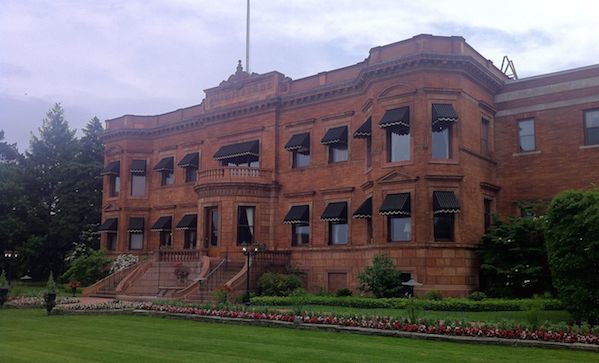This American Independence day, we thought we’d celebrate with our south of the border brothers by discussing one of Canada’s most recognizable products, Canadian Club, and all the help Americans gave Canadian Club courtesy of one of their best ideas, Prohibition. Thanks, America!
Militia Man
Hiram Walker, founder of Canadian Club (and by extension, Walkerville), was a Boston man who travelled to Detroit, a frontier town of 9,000 souls, in 1838. He promptly joined a militia formed to guard the town while Americans crossed the river to attack Windsor in the unimaginatively named Battle of Windsor, putting an end to the Patriot War.
Whisky-Maker
Walker learned the whisky trade as a grocer. At the time, grocers would stock barrels of whisky and people would bring their own jugs to fill. Later he made his own whisky be “rectifying”; that is, he bought distillate from whisky makers, filtered it through charcoal, and blended it himself.
Temperance Movement
Though he maintained his Detroit residence, Walker bought land in Canada to form a distillery. American law prohibited Whisky distillers from rectifying their own product, and the growing temperance movement in the US made Walker worried about the future of the whisky industry.
Warm Welcome
The back of the Canadian Club Brand centre is actually the front; people arrived by boat, or in winter, by sled. Walker and his sons greeted them with whisky and cigars.
Royal Habits
Queen Victoria issued a Royal Warrant to Canadian Club, as did many other European monarchs. Warrants are still displayed. Victoria drank Canadian Club everyday, and towards the end of her life, her personal physician advised her to give up the habit. She only agreed to begin adding water.
Royal Warrants
Stained glass images were commissioned to celebrate Royal Warrants from Queen Victoria in 1898 and King Edward VII in 1901. These were part of the Canadian Club office in London, but were brought to Montreal during World War II, before making their way home to Walkerville.
Whisky & Tobacco
Walker and his sons maintained their own smoking room, which now contains examples of historic whisky bottles and bottles from around the world. It still smells of Cavendish.
The Tunnel
Walker continued to live in Detroit throughout his life—in fact, one of his neighbours was Thomas Edison, which helps explain why the Canadian Club office was one of the first to be electrified in Canada. Walker had a private tunnel dug under the river which allowed him to get home every day. He didn’t walk, though—he pulled a cord, which rang a bell on the US side. There, his carriage driver would send a donkey pulling a cart through. Upon arriving, Walker would feed the donkey an apple and be on his way. The tunnel has been closed since they started dredging the Detroit river.
Prohibition!
Canadian Club sold considerable amounts of whisky during Prohibition—after all, what they were doing was entirely legal on the Canadian side of the border. The company sold to the Purple Gang, and when the Purple Gang met it’s end at the St. Valentine’s Day Massacre, Canadian Club sold to Al Capone.
Speak-Easy
Walker’s one-time wine cellar became a speakeasy during Prohibition years, largely because men like Al Capone didn’t like doing business in the public areas of the office. The wall of the speakeasy still has a bullet hole from a particularly heated discussion.
Bootlegger
During Prohibition, Canadian Club introduced a “Gate Bottle” design. It has a shorter neck than regular bottles and is slightly concave. This allowed bottles to fit snuggly in a box, where they will not break by the neck. These bottles can also easily be secreted on someone’s body or boot—hence bootlegger.
Codes
Coded telegrams allowed whisky sellers to keep track of the considerable amount of product they sold in the US.
Counterfeiters
Counterfeit product was rampant during Prohibition. Counterfeiters had operations next to Canadian Club on our side of the river—including Joe Kennedy.
Just What the Doctor Ordered!
During Prohibition, people could legally buy whisky if their doctor ordered it.
Want to learn more? Be sure to visit the Canadian Club brand centre in Walkerville, Ontario (or, begrudgingly, Windsor). Alternatively, check out Canadian Whisky: The Portable Expert, by Davin de Kergommeaux.
Dave Robson is the editor of DailyXY. He spends his time reading books, drinking Scotch, and smoking cigars.


